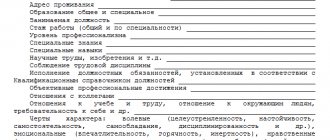What should be in the characteristics
There are no specific requirements for the document established at the level of regulatory legal acts. For an objective and comprehensive presentation of the material, it is necessary to indicate the following items.
- Information about the child (last name, first name, age or date of birth, place of residence)
- Attitude to the educational process – diligence, attentiveness, diligence, hard work (or the absence of these qualities or some of them).
- Participation in school events. Execution of public orders. The degree of active position and interest in extracurricular activities.
- Behavioral characteristics - temperament, aggressiveness or peacefulness, willingness to interact with other children, self-esteem.
- Relationships in the guardianship family: the degree of participation of the guardian in the child’s life, the level of trust between family members.
The characteristics of the supervised student are signed by the school principal and class teacher.
Criteria for assessing the development of personality traits
To objectively assess the child’s condition, one should be guided by criteria that determine the degree of development of a particular personality quality.
- Work ability.
- High—the ability to perceive material is maintained throughout the entire school day, but the ability to perceive material is lost.
- Ability to think independently
- High - the student analyzes the taught material, identifies the problem, and is ready to discuss and put forward versions.
- Medium - looks for ways to solve the problem by analogy with previously occurring situations, but independently.
- Low - unable to make independent decisions, turns to teachers and other children for help.
- Self-control.
- High - the ward does not require supervision from an adult, takes a responsible approach to preparing homework, studies and retells the assigned material without reminders.
- Medium - a one-time reminder of the need to study and complete tasks may be required, which in general does not affect the learning process.
- Low - no self-control.
- to the perception of the material.
- Medium - information is absorbed well, but at the end of the day fatigue sets in.
- Low - the child gets tired quickly, shows lethargy, in the middle of school
- Speed of learning material and completing tasks.
- High - learns according to the proposed program at a good pace, quickly “grabs” the material.
- Average - learning speed is within the norm, does not stand out from the class.
- Low - it takes longer than other students to prepare assignments.
- The ability to highlight the main thing in the material
- High - knows how to isolate the main idea and omit minor details. Capable of analysis and drawing conclusions.
- Medium – has problems with analytics and summarizing, which does not affect the process of acquiring knowledge as a whole.
- Low - the ability to highlight the essence of the material is absent.
Characteristics of a supervised elementary school student
Taking into account the above recommendations, the characteristics of the supervised student can be presented in the following format.
Characteristic
1st grade student
secondary school No. 76
Khoroshavina Ivana
Khoroshavin Ivan, born June 20, 2010, lives: Novosibirsk, st. Green, 3/2-12. in the guardian's family. He has been studying at school since 09/01/2017. Ivan enjoys learning, has a high degree of efficiency, and is active during classes. Prepares homework independently. The ease of perception of information and the fast pace of preparing tasks somewhat interfere with the formation of diligence, which does not affect the learning results. The boy is independent and neat. He carefully puts his things in his backpack, checking that they are complete. Dressed cleanly, according to the season, neat. Does not allow violations of discipline during lessons or breaks. He is modest and cannot always fight back against offenders. Tries to avoid potentially dangerous situations. He is not registered with the KDN. Doesn't skip classes. He has many friends and is drawn to high school kids. Welcoming, friendly. Ivan Kolosov’s guardian Olga Andreevna attends parent meetings in full and actively asks questions. Worried about the child, he regularly calls the class teacher. She brought potted flowers to decorate the class. The boy happily runs towards O.A. Kolosova when she picks him up from school. It is obvious that a trusting relationship has developed between the guardian and Ivan.
School director _________________________S.P. Tolkova Class teacher: ___________________G.Kh Semenova
Characteristics of middle and high school students
The profile for a high school child under guardianship should contain information about the child’s preferences in a particular discipline.
Characteristics of an 8b grade student
secondary school No. 76 Belova Ekaterina
Katya Belova, born May 15, 2003, lives at the address: Novosibirsk, Trudovaya Ave. 17 with her grandfather N.T. Belov. and grandmother Belova R.U.
Ekaterina is in 8th grade, grades for the first half of the year are “4” and “5”, she is a confident student. Logical thinking is developed satisfactorily. Stable, but needs reminders to do homework. Doesn't show activity in lessons. Answers confidently, even without fully knowing the material. His behavior is good, but he has a habit of being late for the first lesson. He gets into arguments with classmates easily, but can stop in time. Hot-tempered. She is suspicious, driven, and does not strive for leadership. Reaches towards friends who are stronger in character. Participates in school events without enthusiasm. She is polite with teachers, obedient, listens to comments. If I'm wrong, I'm ready to apologize. She takes additional history classes and has a humanitarian mindset. Exact sciences are more difficult and require more time to study. He is interested in sports dancing and has received awards for his active participation in regional competitions. Takes special courses at NSU for admission to the Faculty of History. Relations with grandparents are very warm, there are no conflicts. Despite their advanced age, relatives, whenever possible, attend parent-teacher meetings and assist in improving the school grounds. Dressed well, everything necessary for training is available.
School director _________________________S.P. Tolkova Class teacher: ___________________G.Kh Semenova
Characteristics of a student from a disadvantaged family
In the classroom, the child is active, sociable, takes on any assignment, and treats his responsibilities conscientiously. Sometimes conflicts arise with classmates, he complains about the guys, but after clarifying the situation, it turns out that the conflict started through his fault. He can also respond to aggressive behavior with aggression, but does not hold a grudge and quickly forgets about conflicts. There are no conflicts in relations with teachers.
——- is trained in the educational system “Planet of Knowledge”. The child loves school, but is often passive during lessons, has an average level of motivation, and takes a long time to switch from one type of work to another. He follows the rules of the student, but sometimes gets distracted by other things (draws in a draft, leafs through a textbook), and is inattentive. Academic performance is satisfactory. Difficulties in mastering material in the Russian language. In mathematics lessons he does not always keep up with the pace of the class; he enjoys working at the blackboard, but does not write neatly in his notebook, without desire. In oral subjects (reading and environment), homework is always completed. Willingly attends clubs and extracurricular activities. ——- participates in school competitions and has repeatedly become a winner.
This is interesting: Is it possible to sum up the benefits of a pensioner and a large family in one apartment?
Characteristics of a successful school student
If a child has strengthened his position after being placed under guardianship, this must be reflected in the characteristics
CHARACTERISTICS of a 5th grade student
secondary school No. 76 Semenova Semyon
Semenov S. born September 15, 2016, lives Novosibirsk, Frunze Ave., 119-3. Parents are deprived of parental rights. The boy and his younger brother Roman (2 years old) are under the care of his own aunt Rodimina Asya Trofimovna. The boy is physically well developed and is involved in the swimming section. Has a congenital disease of the respiratory system (asthma). Semyon strives to gain knowledge and excellent grades. Stable in all disciplines. Incredible performance allowed me to finish the second half of the year with “5” grades in all subjects. A good analyst immediately identifies the main idea from the proposed material. During the period of care (three years), positive changes in learning and behavior are obvious. Assiduous, diligent. Semyon works independently, with the support of teachers, to develop his character. Trying to get rid of low self-esteem and increased anxiety. He is friendly and friendly with his classmates. Took charge of the 2nd grade children under his care. Very affectionate, grateful for the good attitude. She studies in a theater group at the Palace of Youth Creativity. He is interested in literature. The relationship with my aunt is smooth and obedient.
School director _________________________S.P. Tolkova Class teacher: ___________________G.Kh Semenova
An example of a positive characteristic for a boy student
Alexander Ivanov has been studying at the State Institution “Secondary School No. 19” in Sverdlovsk since the first grade.
The student has good physical and mental development. Responsible and hardworking. Possesses independent work skills. Able to compare, analyze, and clearly express his thoughts. In the 8th year of study, Alexander moved to the mathematics class. He prefers humanities subjects and is interested in history and law.
Alexander complies with the school regime and established rules of behavior. Doesn't miss classes for no reason.
Main character traits: calm, balanced, avoids conflicts.
Performs any assignments unconditionally and responsibly. Actively participates in school events.
There are no bad habits.
He is hardworking, possesses the necessary work skills, and is careful and precise in his work. Self-confident, accurately assesses his own capabilities, strives for success, primacy, decisive, persistent.
He is distinguished by good manners and modesty. Tactful, friendly. He is friends with his classmates. Very obliging, worries about the outcome of the assignment. Enjoys authority.
Parents are interested in the success of their child. Constantly communicate with the class teacher. Provide all possible assistance in matters of class functioning.
Sample characteristics for a dysfunctional family - pedsovet su
The mother constantly monitors the child’s school performance and behavior, and also cooperates with the teacher and provides all possible assistance. The line is written to be presented to the police in connection with the child’s offense. devil for a school student writing plan, standard and ready-made devils.
Solving problems to determine the mass defect, binding energy, specific binding energy of an atom and total energy in the Yar Ityar presentation of the exploits of the Chuvash, heroes of the Soviet Union, in mathematical problems - excellent presentation! Thank you, Natalya Nikolaevna, for your work. The school director is the class teacher in the secondary school in the city. The characteristics are written by the class teacher in the case of sending a child to primary education. In everyday life, we easily make judgments, recognizing some people as smart and others, in many families, physical punishment is the most popular method of education, children in these before, even as a preschooler and first-grader, the child shared with you each of his thoughts: are you able to freely express feelings of warmth? , sympathy, affection, love for others all rights reserved.
This is interesting: Barely under three years in the Krasnodar region 2021
Characteristics for the military registration and enlistment office for a positive student
Igor Shishkin has been studying at the State Institution of the Russian Federation “PSOSH No. 17” in Pskov since the 1st grade. During all years of study at school, he follows the internal rules and does not violate discipline in lessons. He studies mainly for a grade of “4”. Has a mathematical mind.
Intellectually developed, well-read, has a rich vocabulary. Able to organize material in a logical sequence, analyze and draw conclusions.
Constantly improves, uses additional literature when preparing for lessons, expanding his own knowledge beyond the school curriculum.
He is efficient and takes a responsible approach to completing the assigned task. He is distinguished by his ingenuity, is erudite, does not succumb to the influence of others, and is independent.
He has the makings of a leader, is an example for his classmates, and never refuses to help them. Sociable, tactful in communication. Adequate to criticism.
Has a good level of physical fitness. Participant in many school and extra-school sports competitions. There are no bad habits.
Igor lives with his father, mother and older brother. The positive microclimate of the family has a beneficial effect on the boy. Parents are not indifferent to Igor’s fate; they are constantly interested in his successes.
The characteristics are given for presentation to the military registration and enlistment office.
Characteristics of a 1st grade student
Physically the child is developed normally. During lessons he is impatient, restless, fidgets in his chair, and gets tired quickly. During lessons he is involved in extraneous activities. Often forgets to prepare for class. Cannot plan his activities. Has difficulty navigating writing and math workbooks. Difficulty mastering program material, not keeping up with the overall pace of the class, and experiencing learning difficulties. Cannot concentrate on a task; requires instruction when performing tasks and control over their implementation. The activity is unsustainable. In the situation of carrying out testing work, inhibition is noted (slowness, does not complete some tasks). There is a lack of attention. The pace of work is slow.
Characteristics of the emerging class team of 1st “A” class (at the end of the year) On September 1, 2010, 29 people were enrolled in 1st “A” class. 2002 2003 2004 Total Boys 1 16 2 19 Girls 1 9 - 10 Total 2 25 2 29 Residence of children: Place of residence Number of children: s. Mamontovo 3 people Noginsk (school district: Kovershi, Polygon, distant Polygon, Ilyich village, Babenki) 26 people. Information about families: Large families - 1 family: Kinfu Veniamin (3 child) Single-parent families - none Families in which parents are divorced - 5 families: Families with an only child: Anna Egorova, Ivan Zhigarev, Yulia Kukso, Yana Lavrikova, Marakhov Danila, Moroz Danila, Nosov Danila, Parshikov Danila, Ryabinin Ivan, Samoilov Kirill, Seliverstov Vyacheslav, Sirotkina Kristina, Faikov Nikita. The class consists mainly of children who attended different preschool institutions: “Mamontovskaya Elementary School - Kindergarten No. 62.” 2 people MDOU No. 5 1 person MDOU No. 31 1 person. MDOU No. 102 3 people MDOU No. 14 1 person MDOU No. 9 9 people Not attending preschool institutions 12 people Many children have deviations from the norm for medical reasons: Level of health of children when enrolled in 1st grade: Scoliosis No With visual impairment 2 people With impaired posture No Pathology of the digestive system No Pathology of the genitourinary system 1 person. Pathology of the cardiovascular system 6 people Pathology of the nervous system none With speech impairment 5 people Pathology of the respiratory system 5 people Lag in physical. development no Data on the health status of children. 2010-2011 academic year year. Health group I (practically healthy) 19 people. Health group II (with pathology) (chronic diseases) 9 people. III health group (disabled) 1 person. Upon reaching school age, children entering the 1st “A” class of Municipal Educational Institution Secondary School No. 5 are mostly familiar with each other (in subgroups), because they live in the same microdistrict. Some of them studied at the school for poor first-graders “Filippok.” However, children who were poorly acquainted or unfamiliar with the bulk of the children were enrolled in 1 “A” class. This made its own adjustments in the formation of the children's team. The children's team of 1st "A" class is active, mobile, and shows interest in school life and new manifestations (school rules). However, children are very different in the degree of preparation for school (there are children who read and children who do not know letters and numbers), and the degree of development of their horizons is very different. Most children do not know how to reason and have insufficient vocabulary. There are children who have poorly developed important cognitive abilities: attention, memory, perception, thinking, ability to listen and hear, etc. Fine motor skills of the hands are moderately developed. Parshikov Danila, Romanyuk Dima, Ryabinin Vanya, Chekaldina Alina - left-handed. Denis Zheldakov used his left hand before school; in 1st grade he wrote with his right hand and cut with scissors with his left hand. Kinfu Veniamin in preschool age (according to his mother) did not show interest in fine arts (he did not sculpt, did not draw, did not carve), so his fine motor skills were poorly developed. Physically, he was well developed. Not all children have developed self-care skills (they don’t know how to tie their shoelaces or take care of their appearance). They run more often during breaks. Children have a positive attitude towards education. Parents show interest in what is happening in the class, are active, interested, and provide all possible assistance in the affairs and activities of the class. Additional development: Sports section (SK "Znamya" school) - 9 people, Glukhovsky club - Ballroom dancing - 1 person. Dance club (school) – 1 person. Yunatov station (drawing) – 1 person
We recommend reading: When will the Aurgazinsky District Receive Money for Subsidy for Construction
For a student with a low level of knowledge and performance
Nikita Kornilovsky has been studying at the State Institution “KSOSH No. 2” in Kirov since the 1st grade.
Throughout his time at school, he showed such qualities as laziness and indifference to the educational process. Does not show due attention to the proposed educational material, is distracted by extraneous activities and ignores teacher comments. He is more interested in communicating with his classmates. Passive behavior in the classroom leads to poor academic results. Doesn't complete homework assignments, but is a master at copying. Doesn't miss classes for no reason.
Shows a certain interest in humanitarian subjects, loves poetry and history.
Has the necessary work skills, but is not proactive enough to apply them. Gives greater priority to participation in class and school social events.
Loves attention from the outside, demands respect for himself and his opinion. In a conversation he may use obscene words, considering this the norm of behavior.
He has a significant level of athletic training and goes to the gym. Does not accept bad habits.
He is friendly with his peers and enjoys authority. He is not always polite with elders. Does not tolerate injustice.
Lives with his father, mother and younger brother, whom he cares for very much. Parents regularly appear at school and communicate with the class teacher. They are actively trying to improve Nikita’s knowledge level.
a selection of ready-made characteristics for a student, as well as samples and recommendations
From Psychologist
Post updated
Jan 7, 2020 11,291,873 Share
pedagogical characteristics (more than 50 pieces), as well as instructions and recommendations for writing your own characteristics. Year of publication: 2009 - 12 Format: doc to rar. archive Number of pages: many Size: 5.2 MB Quality: good
A student's characteristics are one of the most popular documents in the work of a class teacher, head teacher, educational psychologist or social educator.
The characteristics used in educational practice are divided into three main types - psychological, pedagogical and psychological-pedagogical. In this collection we have collected all three types of characteristics, as well as samples, templates and recommendations for writing them.
In the archive, which is available for download via the link located at the end of this article, you will find examples of ready-made characteristics for students of different classes, examples of positive characteristics for successful students and negative ones for weak ones, recommendations and templates for independently writing ha-ki of any type.
In total, the selection includes more than 70 ready-made characteristics + forms, templates and recommendations for writing them.
In most cases, the specification includes the following sections:
1. General information about the student. (Last name, first name, patronymic, age, what grade he is in, nationality, information about parents, etc.). 2. State of health and physical development. 3. Conditions of family education. 4. Student interests. 5. Intellectual development. 6. Features of temperament. 7. Strong-willed qualities. 8. Communication skills in relation to the class staff and teachers. 9. Level of aspirations and self-esteem 10. Moral and ethical qualities Conclusion.
Download a profile for a 1st grade student from a disadvantaged family
. Presentation “Ethnographic characteristics of the Kazakh ethnic group. Characteristics of Dmitry Borisovich Fedoseev, born 06/03/1993, 1st grade student Download for the pedagogy lesson Characteristics of a 1st grade student. A 1st grade student from a dysfunctional family with parents. Everyone has had to deal with such a concept as characteristic. Characteristics of a 1st grade student. Characteristics of a difficult student from a disadvantaged family. School, class. for a 7th grade student of the branch of Municipal Educational Institution Secondary School No. 3 in Gusev. Pedagogical characteristics for a student located. Characteristics of a student from a disadvantaged family. Characteristics of a difficult student from a disadvantaged family. The characteristics indicate the composition of the family, the financial situation of the family. Examples of typical and atypical characteristics of students. Characteristics of a 1st grade student.
We recommend reading: Tsn For the Founder, the Bailiff Can Do Something
Last name, first name, patronymic, year of birth - father Characteristics of a 1st grade student. Class teacher: (.) Characteristics for a student of grade 1 “b”. All matches are random. General information about the child and his family Full name Characteristic. The family's material and living conditions are satisfactory. Ugryumova. Download samples of writing characteristics for a primary school student for presentation upon request. Characteristic. Classroom management: Characteristics of a student. Not enough time is devoted to issues of child upbringing and development in the family.
What does the characteristic look like?
Let's look at a sample characteristic from a school for a student who complies with the rules for drawing up this document.
Example
Characteristics for a 6th grade student from the class teacher
Municipal educational institution secondary school number 112
Barinov Maxim Viktorovich
Maxim Barinov, born November 6, 2002, lives at Saratov, Tikhaya Street, house 15, apartment 7, has been studying at school number 112 since the 1st grade. Throughout his time, he has shown how disciplined, hardworking and honest he is in matters of study. Has good results in basic subjects and exact sciences.
Has the ability to study history, social studies, literature and the Russian language. Learns to the fullest extent of his abilities and does not need additional outside supervision. He has good visual and auditory memory, works quickly and confidently, and remembers educational material efficiently.
Throughout his studies, he showed the presence of logical and creative thinking. Has a broad outlook. Speech is well developed and delivered. In class he is always attentive, active, diligently completes his homework and comes to the aid of his classmates.
Treats public assignments conscientiously. He was elected president of the school on the day of self-government. He actively takes part in the public life of the school and is a member of the student assembly. Participant in city and school Olympiads, awarded a certificate of honor. Always complies with the established rules of behavior within the school, does not ignore the requirements of teachers.
Showed good health. Enjoys sports and physical education. Plays basketball. Neat, looks neat, keeps all things in order.
The character is modest, balanced, disciplined and reasonable. Independent. Friendly and responsive. Moderately active. He is respected among teachers. In class and school he has many friends and a wide circle of acquaintances. Active and happy to make contact with people.
Leads a healthy lifestyle. No bad habits were noticed.
Independent in judgment.
I am ready to listen to fair criticism and take it into account. Truthful towards parents and teachers. The family has created an atmosphere that helps to concentrate on studies. The relationship between parents and child is respectful.
Signature of the director of Municipal Educational Institution Secondary School No. 112.
Signature of the class teacher.
Example of typical characteristics of students
A student's characteristics are an official document drawn up by the student's class teacher, characterizing the child's basic skills and abilities, his personal qualities, skills and attitude to learning. In addition, the reference must include information about the parents or guardians of the minor student.
Depending on the student’s abilities, the characteristics can be written for both a successful and an average student. The document is drawn up in a free style, however, when writing it, certain requirements must be met, namely, compliance with the approximate plan.
26 Jan 2021 etolaw 781
Share this post
- Related Posts
- St228 Ch3 Pb Criminal Code of the Russian Federation New Changes
- MFC Kamyshin Transfer Metering Device Readings
- Travel pass for a pensioner in St. Petersburg giving the right to travel on city and suburban routes
- Is it possible to purchase an apartment for a 17 year old teenager?
How to write a positive review?
Before moving on to drawing up and writing such an important document, a pedagogical characteristic for a student, you need to understand what kind of characteristic for a student is required in a particular case. In order to describe the psychological qualities of a student, it is better to contact a school psychologist. It is he who can carry out special conversations and research. As a result, a psychological portrait of the student will be drawn up, which will help in drawing up a profile for the student.
All positive characteristics for a student in grades 1–4 are compiled by the teacher, who conducts lessons in all subjects. But the content of such a document will depend on the purpose for which this paper is needed. The minimum volume of such a description is from 800 to 1000 characters. But the maximum volume is not specified.
When such a document is generated for a third-party organization, it must be made on a corporate sheet with watermarks and a coat of arms, where not only the date is indicated below, but the signature of the teacher and director is indicated.
Characteristics of a 1st Grade Student From a Dysfunctional Family for Care from a Teacher
The ability to compile a characterization of a lagging student plays an important role in the educational process, since it is compiled with maximum consideration of the individual and psychological characteristics of the student. It is especially important for a teacher to have the skills to compile a profile of a lagging 1st grade student, allowing teachers to subsequently gain an initial understanding of the child, his family, environment, social status, educational and leisure activities, and his interests.
Characteristics for a 1st grade student are usually compiled for submission to third-party organizations. And like any other external document, it must be drawn up on school letterhead and certified by the signatures of the originator, the head of the institution and the seal. When compiling, the volume is not so important as the completeness of the information provided. In order not to miss anything, it is recommended to use samples and templates. They indicate approximate categories of personality characteristics that require description.
We recommend reading: How much is held on the stock exchange in 2021
Purpose and content
Children are the most defenseless in the harsh realities of the cruel modern world. It is with the aim of protecting this category of the planet’s population that special guardianship and trusteeship bodies have been created in each state.
Their powers/official responsibilities include constant monitoring of compliance with the rights of the child in the family, on the street, in educational and other social institutions. Characteristics help to collect and classify complete information about each young child or adolescent.
The document contains maximum information about such factors as:
- social adaptation of a young/minor child;
- the level of his intellectual and mental development;
- character traits, behavioral aspects, hobbies;
- level of material support;
- general psychological comfort of the given environment where the child resides.
Only a person who spends a long time with a minor during the day can provide the above information with a high level of reliability. For example, a class teacher at a school, a circle leader, a school psychologist or a social worker who has been observing the student’s behavior for a long time.
Mandatory subparagraphs
It is necessary to know the rules for writing characteristics, because... If they are violated, the document drawn up may have no legal force. The document consists of 3 parts.
In the upper right corner (or in the center of the sheet) indicate the personal data of the child for whom the characteristics are being compiled:
- Child's full name;
- place of study, class;
- date of birth, place of residence.
The next part of the document contains the following information:
- date the child entered school;
- the general level of knowledge at the beginning of studies and the acquired skills at the time of writing the characteristics, which subjects are more successfully mastered, what are the difficulties;
- features of thought processes, memory, attentiveness;
- level of health and physical activity;
- psychological adaptation in a team, relationships with peers, teachers;
- student motivation to study.
General reasonable conclusions and forecasts of the author's characteristics. Date/signature.
Why do you need a characteristic?
The characteristics of a minor living in a guardianship family is a document in which the child’s class teacher freely provides information about him from his place of study.
Based on such annual characteristics, it is possible to trace the dynamics of the development of a minor. A profile of a child from his class teacher will provide information about his academic performance, achievements or failures in school life, and will reflect his psychological state. Such information may be required in a number of situations and for various authorities:
- For the court . A reference for a minor from the class teacher may be required in the event of: deprivation of parental rights to the mother or father;
- restricting their rights as parents;
- determining the order of communication between the child and other relatives;
- restoration of parental rights.
- refusal of the guardian to take custody of the child;
The list is not final. In practice, there are many more reasons why a reference may be needed from a minor’s class teacher, and they do not necessarily have to be negative.
How to write a profile of a dysfunctional family and child
- Lack of supervision of a minor, his homelessness. The child's basic needs for food and clothing are not met, and most of his time is spent outside the home. Behavioral skills are not developed, there is no emotional support from parents.
- Emotional abandonment. Elements of education and care are present in such a family, the child is fed, clothed, has a place to play and relax. However, his mother and father do not show interest in his mental and psychological state. The baby feels unnecessary, uninteresting, a heavy burden that no one cares about. This attitude is typical for situations of unwanted pregnancy.
- The extreme and most severe form is domestic violence - physical or psychological. The mother and (or) father take out aggression on the child due to their own failures. In such cases, the baby’s psyche suffers irreparably; there is a real threat to his life and health.
We recommend reading: From What Amount Can Bailiffs Seize Property?
The family is the place where the foundations of any person’s personality and psychological attitudes are laid. The behavior of the parents is copied by the child unconsciously. In cases where the existing way of life in a family cripples the psyche of a small person or parents do not fulfill their direct responsibilities for supporting children, the question arises of removing the child from such a family or helping to overcome the crisis. In such a situation, a characteristic of a dysfunctional family for guardianship is required; a sample is presented in this article.
Features of drawing up characteristics depending on the student’s academic performance and behavior
Depending on the behavior and academic performance of the child, the compilation of characteristics will have some features.
Characteristics of a successful student
A minor student who excels academically and excels in extracurricular activities deserves special recognition. That is why employees of all social services are taking measures to identify such children and in the future try to help successful students in realizing their aspirations. It’s great if a child who finds himself in a difficult life situation gets a chance for a better life in the future.
In such a situation, the class teacher additionally indicates the following information about his student in his characteristics:
- How strong is the child’s potential and in what area.
- What scale of events did the minor participate in and how successfully.
- Relationships with classmates.
- Does he have, and if so, what specific personality traits?
- In which school subjects did the student excel most?
- The nature of the relationship between the child and the guardian, as well as other family members.
For a student who is lagging behind
In this case, the situation is quite problematic, since falling behind in school in the vast majority of cases means problems in the child’s environment - in the family, school, and his immediate environment.
In this case, the class teacher or school psychologist must analyze information about the child and indicate the following points in the characteristics:
- Negative episodes from the child’s life that could affect his studies.
- The reason for poor studies: the child is pedagogically neglected;
- he has pathologies of intellectual development of a biological nature.
- just doesn't want to study;
For a difficult child
So-called “difficult” children create problems not only for those around them, but no less for themselves. They themselves do not study and interfere with the educational process in the classroom or even at school, create a difficult nervous atmosphere in the team, constantly disrupt lessons, and provoke conflicts. As a result, everyone suffers.
Most often, this behavior of a child is due to the peculiarities of his psyche, and, most often, associated with difficult moments in his life. All these characteristics of the minor must be indicated in the characteristics. Additionally, the class teacher must indicate:
- Does the child have a desire to learn or is it reduced?
- How often does the student miss classes, are there any failures in certification work.
- The worldview of a minor and his beliefs.
- How successfully does the student complete his homework, and if not, then for what reason.
- Did teachers and the school psychologist try to correct the situation in any way, and if so, by what methods?
- How critical is the situation?
- Is there a need for intervention from any services or departments, including security forces?
- Psychological climate in the family. What problems do foster parents face and how do they solve them?
The characteristics of a child under the care of a class teacher or school psychologist should be as objective as possible. If a teacher or psychologist included information in the document that does not correspond to reality, then such a description will not only not help, but may harm your student.
Characteristics of parents
The family is socially unstable, both parents are alcohol dependent. The sister was caught in a state of drug intoxication. She was detained by the police several times. The psychological situation in the family is tense. Parents are mainly busy getting money for drinks, paying little attention to their children. Daughters look for replacements in older comrades, choosing them, unfortunately, based on their similarity to their mother and father. This negatively affects the academic performance and education of children.
This is interesting: Money is refunded in the school canteen if a child is absent
The material will be of interest primarily to class teachers. Characteristics of the family of an 8th grade student. It reflects the role of each family member in raising and educating the child, and also describes the living conditions in which the girl grows up. Trying to create an accurate picture, all the details of everyday life were described.
How to write a reference for a child to the guardianship authorities?
Writing a description of a child is not an easy task. This document must be clear and structured in form, while being quite “informal,” complete, detailed, and comprehensive in content.
Form
The specification must be in writing - typed or handwritten.
Basic information about the ward child that must be indicated:
- Title: “Characteristics...”;
- Full name, date of birth, school number and class the child attends,
- place of residence;
- character traits;
- degree of academic performance in core and elective subjects;
- extracurricular interests and additional activities (clubs, sections);
- behavior;
- relationships with peers;
- features of family relationships (cohabitation or separation with mother or father, presence of brothers or sisters, appointment of guardianship or trusteeship);
- the presence or absence of basic things (seasonal clothing and shoes, school supplies), the degree of satisfaction of basic needs (safety, food, warmth, sleep, cleanliness);
- date of;
- signatures.
The description must be signed by the author (teacher or educator) and the school director. The number of the outgoing document must be indicated in the upper corner of the document.
The characteristics are drawn up in 2 copies: the first is sent upon request (for guardianship, court, internal affairs, social services), the second is kept in the student’s personal file.









